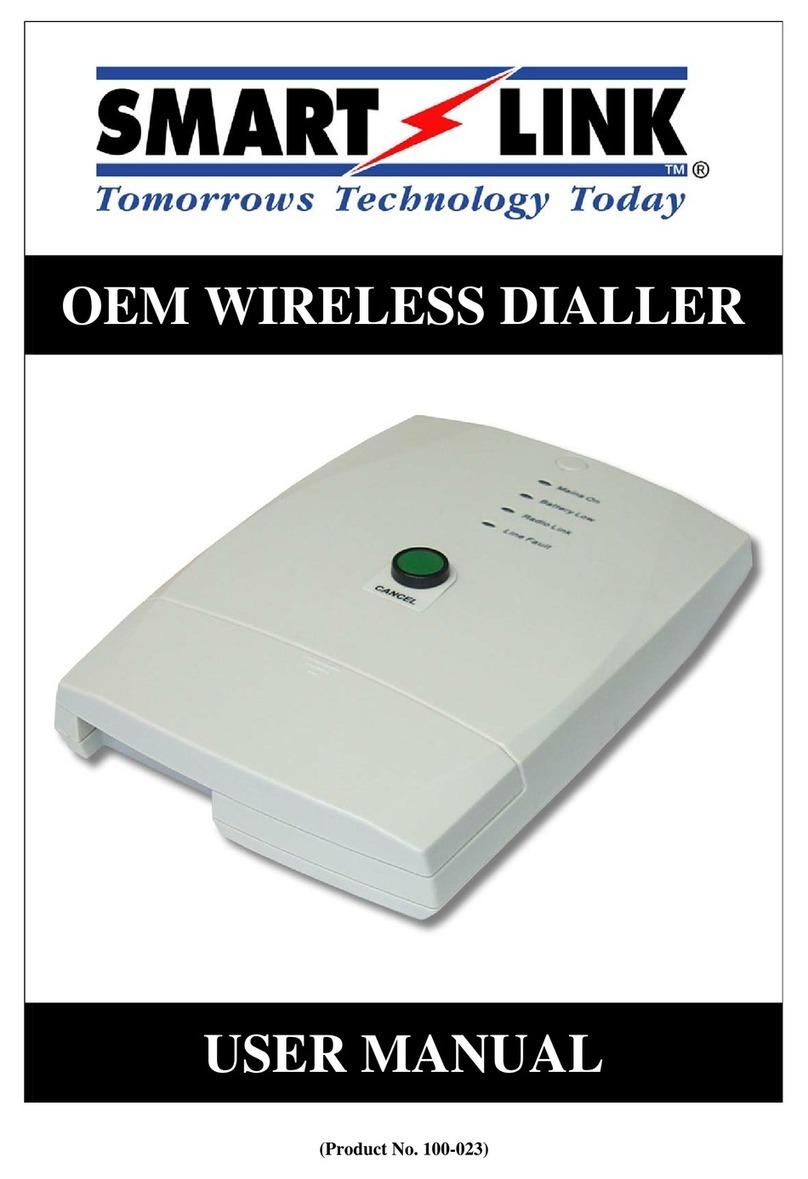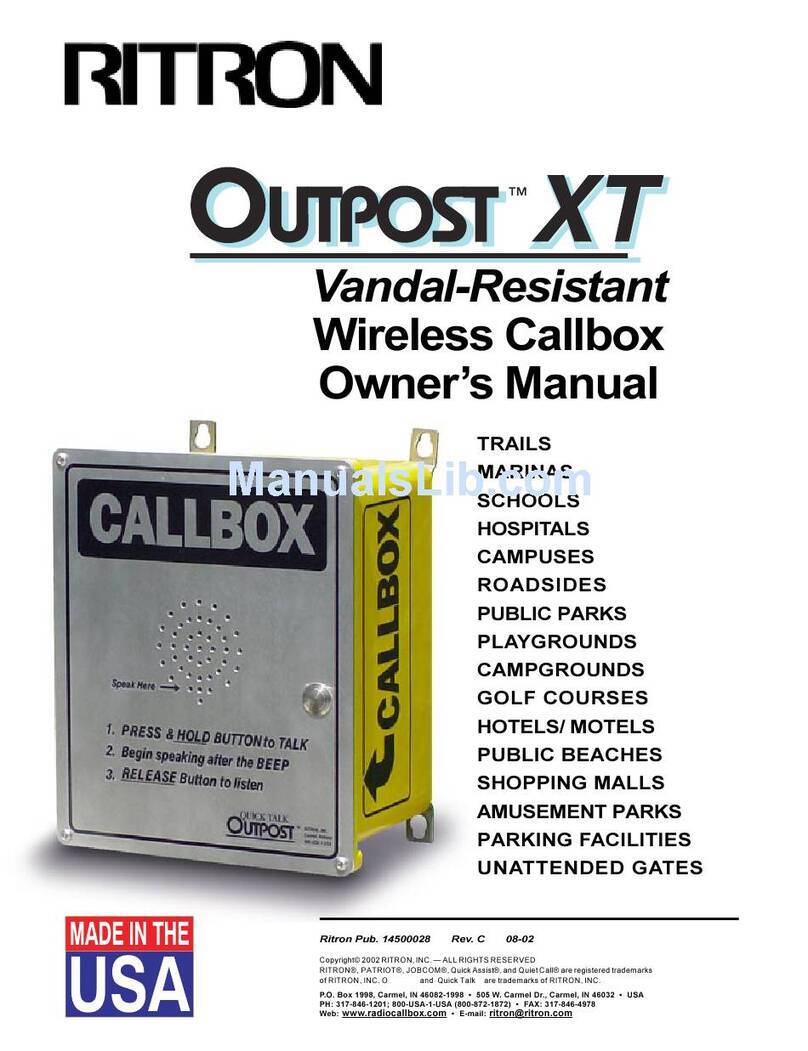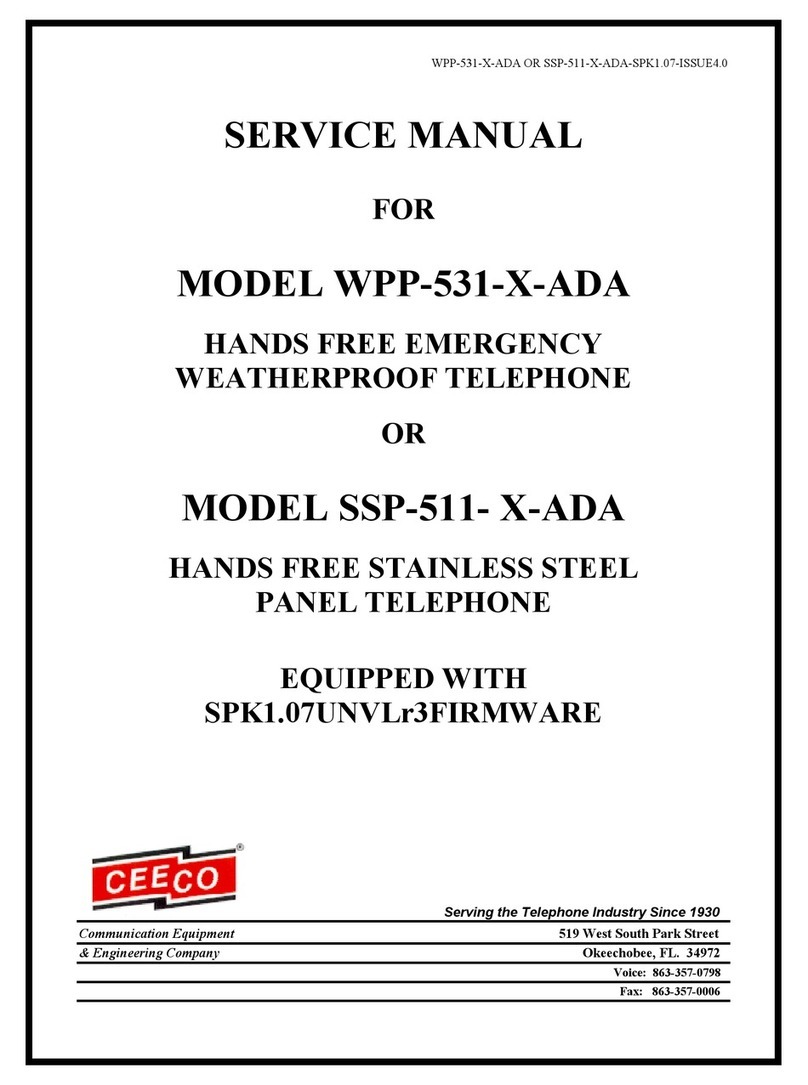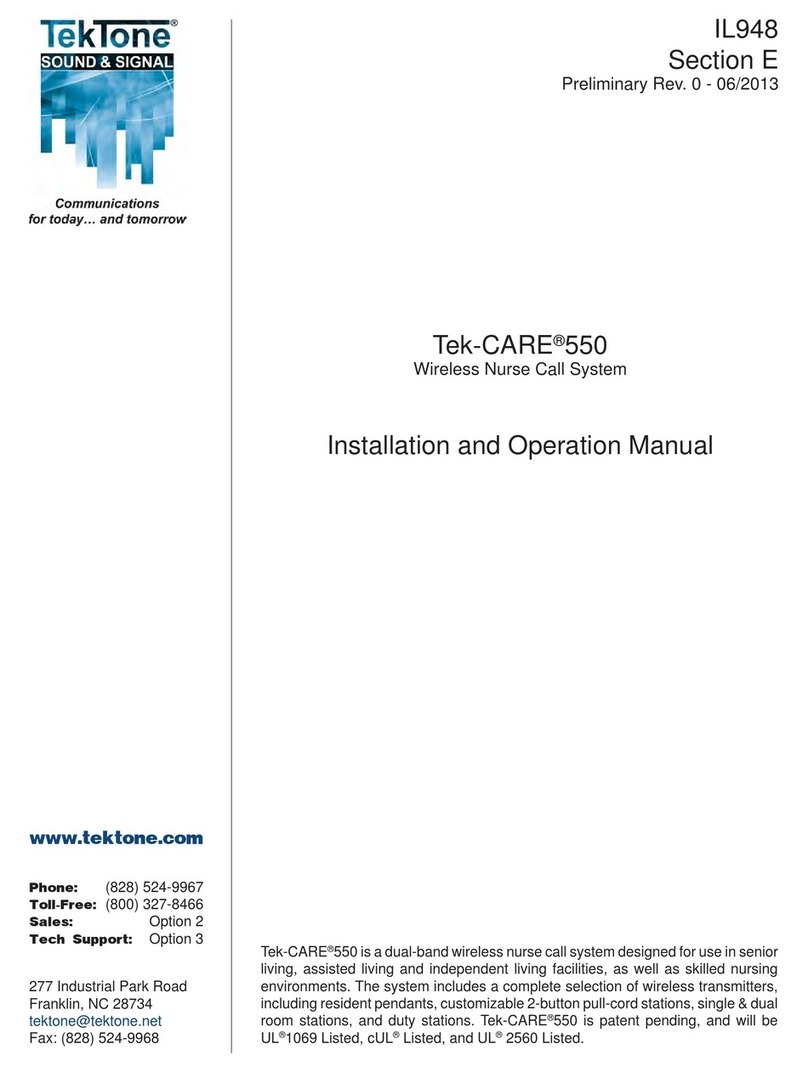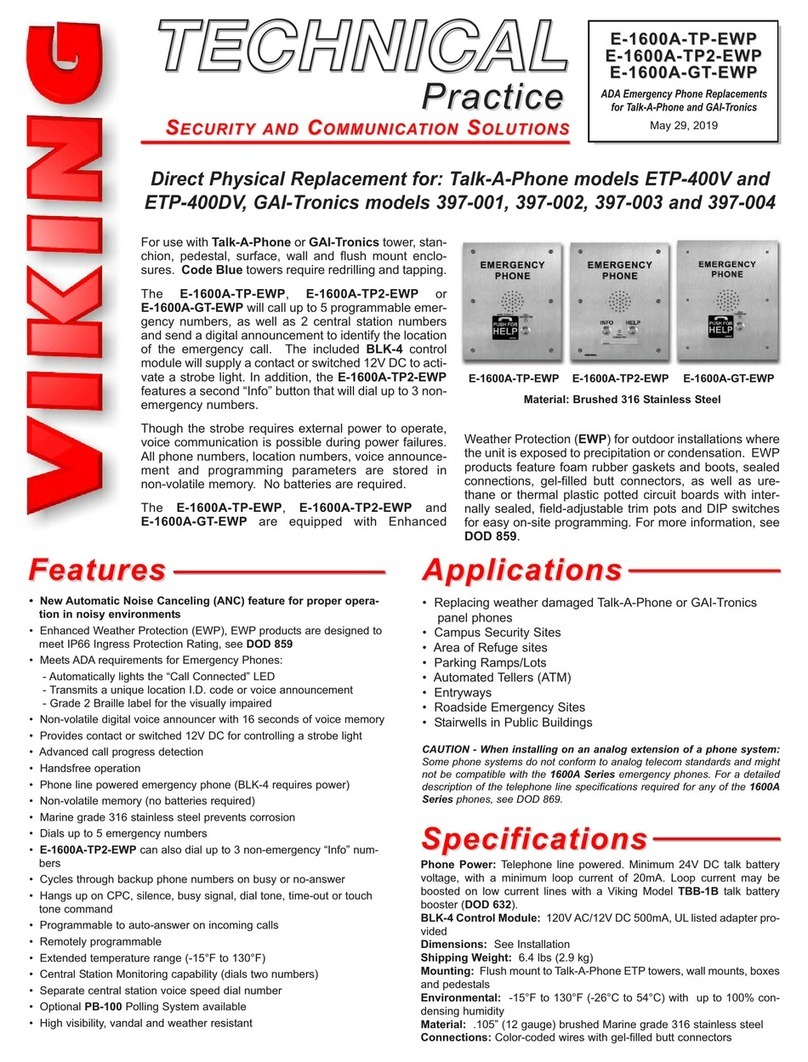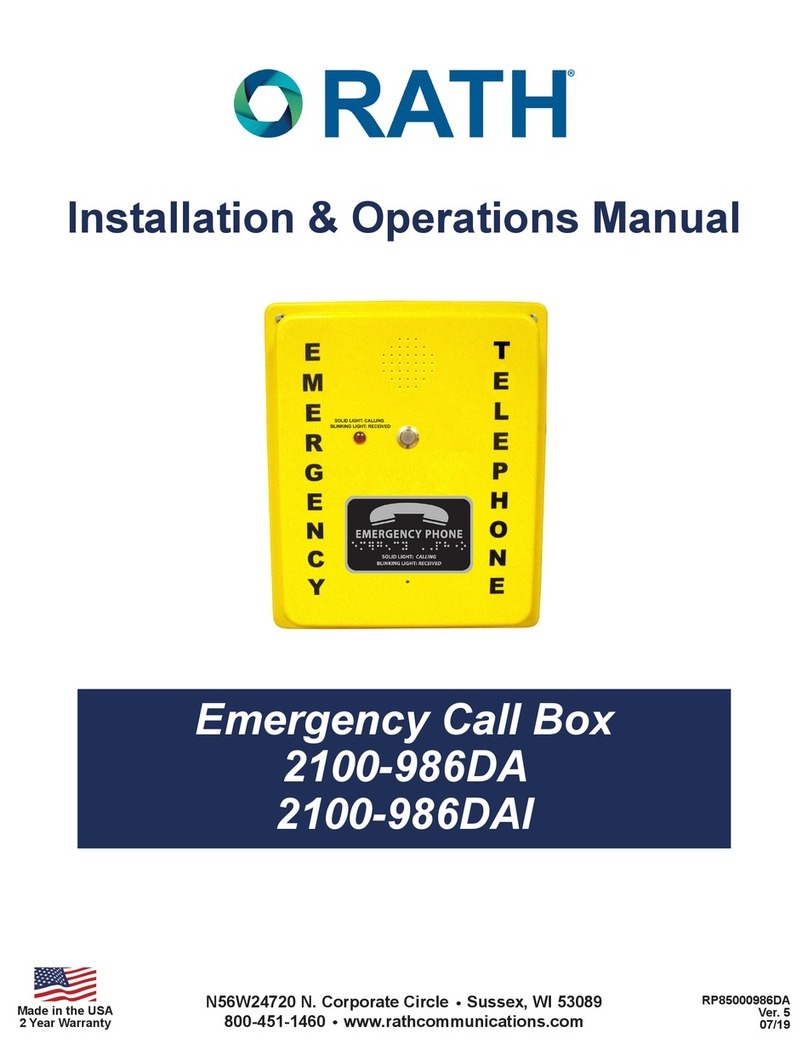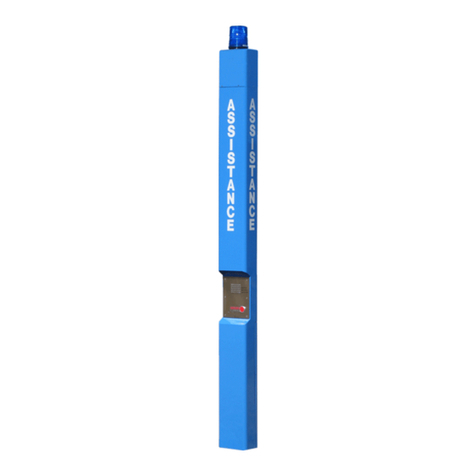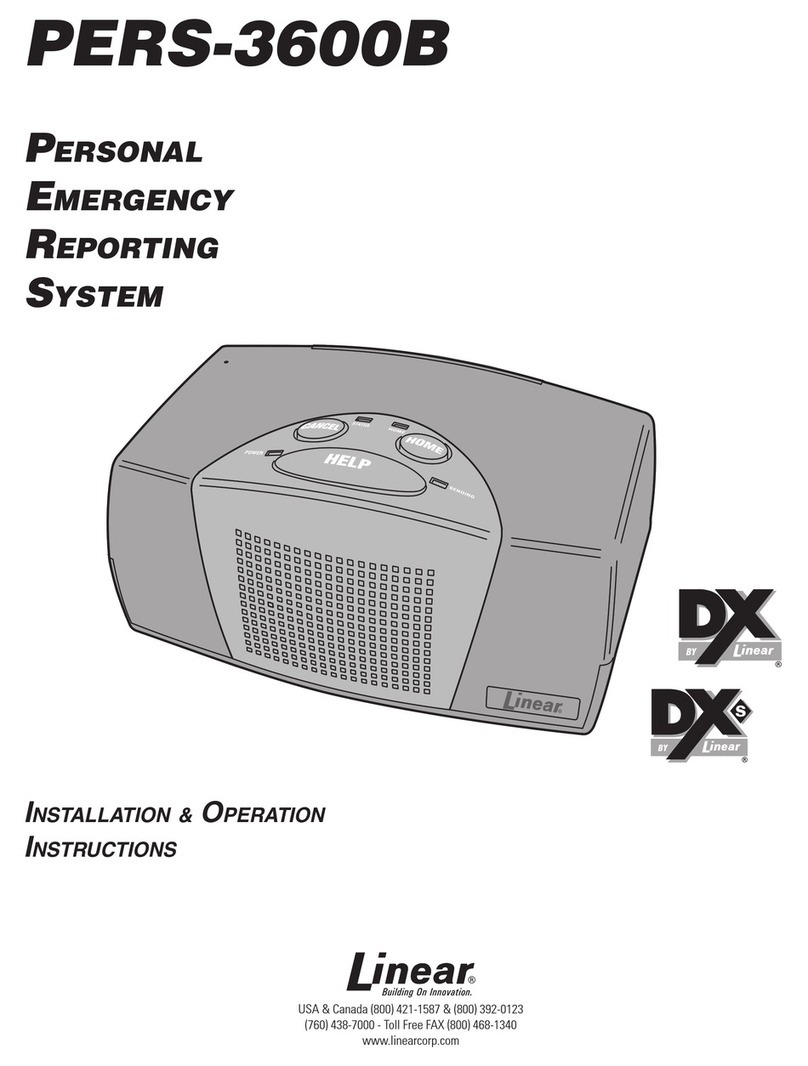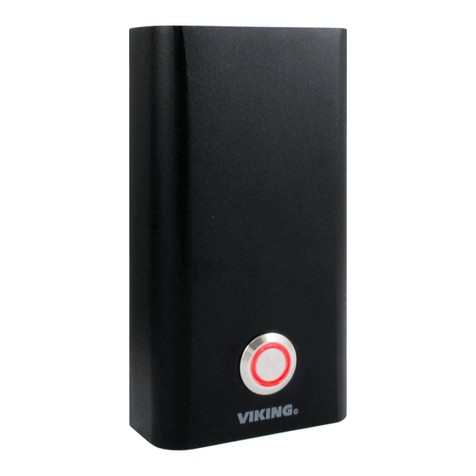ASCOM Care Phone GSM User manual

TD 92816EN
17-July 2012 / Ver. B
Programming and Installation Manual
Care Phone Analog
Care Phone GSM

TD 92816EN
17-July 2012 / Ver. B
Programming and Installation Manual
Care Phone
COPYRIGHT
© 2011 Ascom Tateco AB
The material in this manual is protected by copyright law and international
treaties. It is intended to be used by Ascom Tateco employees and distributors.
Our authorisation is required for reproduction and / or distribution of any
material herein to others.
DISCLAIMER
Ascom Tateco AB has taken due care in preparing this document including re-
search, development and testing to ascertain the effectiveness of any
programmes and data on electronic media which accompany this document.
Ascom Tateco AB makes no warranties as to the contents of this document and
specifically disclaims any implied warranties pertaining to fitness for any
particular purpose. Ascom Tateco AB further reserves the right to make changes
to the specifications of the programme and contents of this document without
obligation to notify any person or organisation of such changes.
ADDRESS
Ascom Tateco AB
Wireless Solutions
P.O. 8783
SE-40276 Göteborg
Sweden
Phone: +46 31 55 93 00
Fax: +46 31 55 20 31
www.ascom.com/ws

TD 92173GB
17-July 2012 / Ver. B
Programming and Installation Manual
Care Phone
Contents
1 Introduction ................................................................................................................................. 2
1.1 Care Phone Analog / Care Phone GSM ................................................................................... 2
1.2 General Description of the Tx4 Alarm Transmitter .................................................................. 3
1.3 New functions of Analog Care Phone / GSM Care Phone ....................................................... 4
1.4 Buttons .................................................................................................................................. 5
1.5 LEDs ....................................................................................................................................... 6
1.6 Battery ................................................................................................................................... 7
2 Installation ................................................................................................................................... 7
2.1 Programming ......................................................................................................................... 8
2.2 Connection to power supply .................................................................................................. 8
2.3 Connection to the analogue telephone network .................................................................... 8
2.4 Connection to mobile network ...............................................................................................9
2.5 Wall Mounting ....................................................................................................................... 9
2.6 After Completed Installation .................................................................................................. 9
3 Programming Structure ............................................................................................................ 10
3.1 Table of Alarm Receiver Telephone Numbers ......................................................................... 10
3.2 Table of Alarm Receivers' Addresses ..................................................................................... 11
3.3 Table for Alarm Types ........................................................................................................... 11
3.4 Table for Sequences ............................................................................................................. 12
4 Programming of the Hand Terminal ........................................................................................ 13
4.1 Introduction to the Hand Terminal ........................................................................................ 13
4.2 Creating and Saving Programming in the Hand Terminal ...................................................... 15
5 Programming of the Analog Care Phone / GSM Care Phone ................................................. 22
5.1 Programming of the Care Phone using the hand terminal ..................................................... 22
5.2 Programming via buttons on the top of the Care Phone ....................................................... 25
6 Battery Replacement ................................................................................................................. 29
6.1 Battery replacement for the Care Phone ............................................................................... 29
6.2 Battery replacement for Tx4 ................................................................................................. 30
7 Commands to the Care Phone .................................................................................................. 31
7.1 Home phone ........................................................................................................................ 31
8 Type of alarm ............................................................................................................................. 32
8.1 Overview .............................................................................................................................. 32
8.2 Explanation .......................................................................................................................... 33
9 Description of menu selection in the Hand Terminal ............................................................. 35
9.1 Main menu .......................................................................................................................... 35
9.2 Programming ....................................................................................................................... 35
9.3 Program ............................................................................................................................... 36

TD 92173GB
17-July 2012 / Ver. B
Programming and Installation Manual
Care Phone
9.4 Attempts .............................................................................................................................. 39
9.5 Connection type .................................................................................................................. 39
9.6 Outgoing call ....................................................................................................................... 39
9.7 Incoming call ........................................................................................................................ 40
9.8 Timers .................................................................................................................................. 40
9.9 Test Alarm ............................................................................................................................ 41
9.10 Link Test ............................................................................................................................. 41
9.11 Extended ............................................................................................................................ 42
9.12 I/O (Inputs / Outputs) .......................................................................................................... 43
9.13 GSM functions ................................................................................................................... 45
9.14 Advanced ........................................................................................................................... 45
10 Appendix .................................................................................................................................. 46
10.1 Appendix A -Specific information for your hand terminal ................................................... 46
10.2 Appendix B - Factory default values for the reset hand terminal .......................................... 48
10.3 Appendix C - Technical specifications for Care Phone ......................................................... 54
10.4 Appendix D - Technical specifications Tx4 alarm transmitter ................................................ 55
10.5 Appendix F - Cable for Input / Output ................................................................................ 56
10.6 Appendix G - WEEE Directive ............................................................................................. 57
10.7 Appendix H - Programming tree Analog Care Phone / GSM Care Phone ............................. 58

TD 92816EN
17-July 2012 / Ver. B 2
Programming and Installation Manual
Care Phone
1 Introduction
1.1 Care Phone Analog / Care Phone GSM
There are currently many types of telephony; therefore Ascom's new Care Phone
comes in several models in order to allow you to communicate in different ways.
You can make an analogue emergency call or via GSM, or calls can be sent as
data traffic over IP or GPRS, this user manual describes the operation of the two
analogue models: Analog Care Phone and Care Phone GSM. The manual for the
most part covers both models, but the part that deals with GSM, of course, only
applies to Care Phone GSM. When both models are referred to in the text it
states, Analog Care Phone / GSMCare Phone.
Care Phone Analog and Care Phone GSM can transmit both speech and non-
speech emergency alerts, to 10 different pre-programmed alarm recipients via
the analogue telephone network and/or GSM network, and Care Phone GSM can
also send alerts to 8 different alarm recipients via GPRS. The alarm recipients
then forward the alarm to, for example, mobile phones, local wireless phones or
an alarm centre, depending on the time and day. Dialling to the various alarm
recipients is done in a predetermined sequence, and may differ depending on the
type of alarm.
The alarm activation is done by pressing the red button on the Care Phone or by
pressing the red button on the portable alarm transmitter. If the transmitter is
used the alarm signal is transmitted to the Care Phone using a radio signal. The
Care Phone transmits the alarm to the pre-programmed alarm recipient. If it is a
voice alarm, like the normal medical alarms, the emergency operator can hold a
conversation with the person who activated the alarm. The Care Phone is
equipped with both microphone and speaker and works as a speakerphone,
which allows calls with no additional push of a button from the user's side.
Conversation can be held in a normal sized apartment with good sound quality.
The Analog Care Phone/ GSMCare Phone is connected to the telephone network
by a cable. If the Care Phone has GSM functionality it connects to the GSM
network through a SIM card installed in the intended SIM card holder. For power
supply the supplied AC/DC transformer is connected. In the event of a power
failure the Care Phone is powered by the built-in accumulator (see section 1.6).
In addition to the alarm transmitter, Tx4 can connect additional radio transmitted
alarm accessories, such as door, IR or smoke alarms. Fixed-line alarms can be
used through the STT Radiobox 869, T-box 869 or via the additional card in the
Care Phone (note that it requires a specific model of Analog Care Phone which
has an extra socket for this purpose.) In total, 16 radio-based devices can be
connected at one time, including the Tx4, the portable alarm transmitter, which
is supplied with the Care Phone.

TD 92816EN
17-July 2012 / Ver. B 3
Programming and Installation Manual
Care Phone
1.2 General Description of the Tx4 Alarm Transmitter
Image 1. Analog Care Phone / GSM general description
Alarms can be activated with the alarm transmitter Tx4. When the red button is
pressed a red LED lights up on the transmitter for a short period. When the
alarm has been received by Analog Care Phone / GSMCare Phone a signal is sent
back to the alarm transmitter to confirm that the alarm has been activated, then
a green LED lights up briefly.
Tx4 uses dual frequency, which is a new feature that allows it to change
frequency and transmit on another frequency if there is a disruption on the
primary frequency. When an alarm is activated Tx4 first broadcasts on one
frequency. If there is no response from the Care Phone the signal is repeated up
to three times. After which, the Tx4 changes frequency and transmits on the
second frequency, up to four times. This feature provides increased security and
safety for the user. The radio frequencies used are the European-customised
frequency for social alarms 869.2125MHz and 868.3000MHz.
The Tx4 alarm transmitter can automatically send a link test to the Care Phone,
which shows that the Tx4 is working properly and has contact with the Care
Phone. If the link test does not reach the Care Phoneit will send an alarm to a
pre-programmed alarm recipient about the failure of the test alarm from the Tx.
The function is activated in the Care Phone with the help of the handterminal.
The alarm transmitter Tx4 is worn on a bracelet or necklace. The alarm
transmitter is also waterproof (IP67) so that the alarm transmitter can be worn
during a bath or shower. A new feature of the Tx4 is that change of battery is
possible. See section 6.2.

TD 92816EN
17-July 2012 / Ver. B 4
Programming and Installation Manual
Care Phone
1.3 New functions of Analog Care Phone / GSM Care Phone
Analog Care Phone / GSMCare Phone has many new features and options. A
selection of them is listed below.
1.3.1 Dual Frequency
Dual frequency allows Analog Care Phone / GSMCare Phone to receive radio
signals on two different frequencies 869.2125 MHz and 868.3000 MHz. Dual
frequency provides extremely good security: if something were to disrupt the
communication on one frequency, the alarm can reach the Care Phone on the
second frequency.
1.3.2 Greater amount of telephone numbers and sequences
In Analog Care Phone / GSM Care Phone you can add 10 phone numbers and
there are now 8 sequences. Each sequence can have 10 steps. Sequences can
also be connected in series, so that when the Care Phone rings in accordance
with one sequence, it can continue to call in a different sequence. This provides
great opportunities for extensive and flexible programming.
1.3.3 GSM functionality
With the Care Phone GSM you have the ability to activate an alarm over the
mobile network, which provides good security if the analogue telephone
network is down. For each telephone number you can choose if the
communication is to be made via telephone lines or wirelessly via the mobile
network. You can also send an alarm via GPRS. Therefore, you can also program
internet addresses in the Care Phone GSM. You can set the APN you wish to
connect to, and the PIN of the SIM card, if a PIN is to be used.
1.3.4 Illumination of the alarm button
Something that has been requested is for the Care Phone's alarm button to be
illuminated, so that it is easier to find in the dark. This feature is a part of Analog
Care Phone / GSM Care Phone. Illumination of the alarm button can be turned
on or off, and you can also easily adjust the brightness to your liking.
1.3.5 Location code
Analog Care Phone / GSM Care Phone has a new feature which means that a
location code can be entered for each alarm transmitter. Location codes are
numbers that you can enter yourself for different places in the home, e.g.,
kitchen, bedroom, hall. In this way it is possible, for example, to know which
door alarm has been activated, the one located at the main entrance or the patio
door.

TD 92816EN
17-July 2012 / Ver. B 5
Programming and Installation Manual
Care Phone
1.4 Buttons
Analog Care Phone / GSM Care Phone has three buttons on the top, all designed
to be easy to push on. The buttons are:
• Active Alarm (Red)
• Reset (Green)
• Present/Ready (Grey)
When you press the alarm button (or alarm transmitter) the Care Phone normally
waits for 10 seconds before the alarm is redirected. During this time, you hear an
alarm signal and the alarm can be cancelled by pressing the green button. Some
alarms ring silently, for example, technical alerts such as test alarms and the
battery alarm. These cannot be cancelled with the green button.
If you wish a Present/Finish function can be activated so that the grey button on
the Care Phone can be used to register when staff are currently with the care
recipient. (This is done via the hand terminal. The feature is found in the menu,
"Plus Alarm.") When the staff arrives to the care recipient, they notify this by
pressing the grey button on the Care Phone. When the button is pressed, the
alarm signal and present indicator light up on top of the Care Phone. When the
staff is ready to leave the care recipient, the grey button is pressed again and a
received signal is heard. In this way, information on the length of stay can be
collated in the system for each individual care recipient.
1.4.1 Button features
The table below describes the functions activated via buttons:
(1) Requires that the feature is enabled in the Care Phone.
(2) See instructions in section 5.2.
For a description of the functions in the programming mode, see section 5.2
Control Function
Press the red button in normal mode Alarm is activated
Press the red button when the phone is ringing (1) The call is connected
Press green button during the call (1) Dialling of the alarm is cancelled
Press grey button during the call (1) Present / Ready signal
Hold the green button down, press the grey and red.
Release on audio signal.
Programming Mode
Hold the green button down, press the grey and red.
Release when the LEDs flash rapidly.
Restart
Hold the green button down, 2 press the red button(1) Present / Ready
Hold the green button and red button down for 3 s Manual, test alarm
Press green button down during start-up Activate function test
Hold red button down during start-up (2) Programming mode of radio
transmitters
Press the grey button in the transmitter programming
mode (2)
Deprogramming of radio
transmitter
Hold down the green button for three seconds (2) Away mode is activated /
deactivated

TD 92816EN
17-July 2012 / Ver. B 6
Programming and Installation Manual
Care Phone
1.5 LEDs
On the top of the Care Phone there is a green light that indicates if the Care
Phone has power, a yellow/orange light indicates the function present and a red
light to indicate if something is wrong. The following table describes the LED
signals and statuses:
If the Warning System function is enabled, the LEDs provide additional
information. The error that is indicated can be found by counting the number of
times the red LED flashes while the green LED is lit. The red LED flashes are
described in the table below:
Signal Status
Green on continuously Normal operation
Green flashing (0. 5 s on / 4.5 s off) Battery power
Green flashing (0. 5 s on / 0.5 s off) Dialling
Green flashing (1 s on / 1 s off) Waiting to call again
Green flashing (2 s on / 2 s off) No more attempts
Green flashing (70 ms on / 70 ms off) Starting GSM mode
Yellow on continuously Staff present
Yellow flashing Carephone set in away mode
Yellow and green flashing
(2 yellow flashes per green flash)
Battery power and staff present
Yellow and green simultaneous flashing Battery power and off mode enabled
Number of
Flashes
GSM
Error
Bad/Low
Battery
Power Supply
Failure
Telephone
Line Break
1NoNoNoYes
2NoNoYesNo
3 No No Yes Yes
4 No Yes No No
5 No Yes No Yes
6 No Yes Yes No
7 No Yes Yes Yes
8 Yes No No No
9 Yes No No Yes
10 Yes No Yes No
11 Yes No Yes Yes
12 Yes Yes No No
13 Yes Yes No Yes
14 Yes Yes Yes No
15 Yes Yes Yes Yes

TD 92816EN
17-July 2012 / Ver. B 7
Programming and Installation Manual
Care Phone
1.6 Battery
In order for the Care Phone to function even when there is a mains loss (power
cut), there is a rechargeable NiMH battery in the Care Phone. The battery has a
very long shelf life and the Care Phone sends a battery error when it needs
replacing. Charging the battery starts automatically when voltage returns. Care
Phone Analog and Care Phone GSM have different batteries. The standard
battery in Care Phone Analog provides backup for about 100 hours. The
rechargeable battery, which is standard in Care Phone GSM is more powerful and
gives backup for up to 420 hours.
Note: Only the battery supplied by Ascom may be used.
2 Installation
Everything that is needed for the installation is:
Placement of connectors, battery and SIM card in the underside of the
Carephone:
Image 2. Placement of connectors, battery and SIM card
1 x Carephone 1 x Telephone adaptor
with cable
1 x Mains adaptor

TD 92816EN
17-July 2012 / Ver. B 8
Programming and Installation Manual
Care Phone
2.1 Programming
The Care Phone must be programmed before it can be installed with the care
recipient. To program the Care Phone, follow the instructions in section 5.1.
2.2 Connection to power supply
The mains adapter is plugged into an ordinary electrical socket and to the socket
on the back of the Care Phone marked 12V (see image 3 below). Then, turn on
the switch (push button marked 0 / 1 to 1).
Note: Analog Care Phone / GSM Care Phone may only be used with the supplied mains
adapter.
2.3 Connection to the analogue telephone network
Connect the telephone cable into the supplied telephone adaptor and to the
Care Phone in the socket closest to the on/off button (see Image 3 below). The
regular telephone plug should be connected to the supplied telephone adaptor
and then connected to the primary telephone socket at home.
Note: It is important that the Care Phone is connected to the primary socket (the main
socket) in the home in order to achieve complete security! If you do not do this, your Care
Phone may not be able to call the alarm recipient, for example, if you have another phone
in the home that is not on the receiver. To check which the primary socket is, lift all the
handsets off the receivers in the home. The handset which still has a dial tone is the
primary. If more than one handset has the dialling tone at the same time, the phone
socket is not connected properly and must be adjusted by an authorised installer.
The following illustration shows which jack the telephone cable (white) and
mains adapter (black) are to be connected:
Image 3. Telephone cable and power cable connections

TD 92816EN
17-July 2012 / Ver. B 9
Programming and Installation Manual
Care Phone
2.4 Connection to mobile network
To insert a SIM card in Care Phone GSM:
1Loosen the screw to the battery cover and pull it out.
2Slide the SIM card into the holder as shown in image 4 below.
3Slide the battery cover back in place (hold the SIM card if it does not slide easily) and
attach the cover with the screw.
Image 4. Slide the SIM card into the SIM card holder
2.5 Wall Mounting
If the Care Phone is to be mounted on the wall, you can choose which way it
should be mounted. Then press out the cover for the selected holes. The distance
between holes is about 110 mm and 42 mm. It can be beneficial to use the back
cover of the Care Phone as a template when you mark where to place the
screws. Use screws with heads that fit the holes so that the Care Phone can
easily be hung up and lifted off when necessary.
2.6 After Completed Installation
After the basic programming, installation and programming of the alarm
transmitter has been completed, carry out a function test.
• Carry out a range test (see instructions in Section 5.2.5)
• Try to send an alarm. If the alarm is to go via the analogue telephone line and via GSM
- be sure to try both.
Note: The back cover of the Care Phone should be on to ensure the best sound quality!

TD 92816EN
17-July 2012 / Ver. B 10
Programming and Installation Manual
Care Phone
3 Programming Structure
This section helps you to structure the values to be inserted into the hand
terminal, which is then used to program the Care Phone. Read through it and
then fill in the corresponding tables in Appendix A at the end of this manual. The
completed tables facilitate the programming of the hand terminal.
3.1 Table of Alarm Receiver Telephone Numbers
In order for Analog Care Phone / GSM Care Phone to transfer an alarm to an
alarm recipient via an analogue telephone line or GSM connection, it is necessary
to program it with the following information:
• Phone number to the alarm receiver (or receivers if there are more than one)
• Protocol, i.e., which transfer method is to be used, such as STT, CPC, etc.
• Alarm code that tells the alarm receiver which Care Phone sent the alarm
• Number of attempts the Care Phone will make to the different alarm telephone numbers.
• If the communication is to go via analogue or via GSM.
When the user programming has been completed, it may look like the table
below. Fill in the values of your programming in the table in Appendix A.
(1) The alarm codes need only be entered if the alarm is to be sent with different
alarm codes to the various alarm receivers.
(2) Only available if the Care Phone has GSM functionality.
Note: If you want to call the same number first over the telephone line and then wireless
via GSM (or vice versa) you must enter this number twice (see code A and code B) and
specify the different connection types.
Number Telephone no. Protocol Alarm Code (1) No. of attempts Connection (2)
A 0406252500 STT 1234 3 Telephone line
B 0406252500 STT 1234 3 Wireless
C 0406252500 STT 1234 3 Telephone line
D 020223242 STT 111234 5 Wireless
E- -- -
F- -- -
G- -- -
H- -- -
I----
J--- -
N (Night mode) - 020223242 STT 123456 5 Wireless
V (Forwarding) - - - - -

TD 92816EN
17-July 2012 / Ver. B 11
Programming and Installation Manual
Care Phone
3.2 Table of Alarm Receivers' Addresses
A major innovation in Care Phone GSM is the ability to communicate over GPRS.
For the Care Phone to transfer an alarm to an alarm receiver via GPRS it is
necessary to program it with the following information (this table is therefore
only applicable if the Care Phone has GSM functionality).
• Internet address to an alarm receiver (or receivers if there are more than one) and port,
separated by semicolons. Internet address can be entered both as text and as a
numeric IP address.
• Protocol, i.e., which transfer method is to be used, STT IPACS is standard.
• Alarm code that tells the alarm recipient from which Care Phone the alarm has been
sent
• Number of calls the Care Phone shall make to the different alarm telephone numbers.
• As Care Phone GSM does not have a fixed IP connection all communication to the
IP addresses is wireless.
When the user programming has been completed, it may look like the table
below. Fill in the values of your programming in the table in Appendix A.
3.3 Table for Alarm Types
The types of alarms that are activated in the Care Phone, both the automatic and
the manual, can be sent to different alarm receivers or be handled in a different
manner depending on the type of alarm. For example, you can choose to deal
differently with technical alarms than alarms activated by the care recipient, such
as medical alarms. The table below shows a configuration example.
Note: The Plus Alarm and Test Alarm can now be configured to run in different
sequences. The bedside alarm, carpet alarm and door alarm now have their own
sequence, and are no longer sent in the same way as a Passive Alarm.
Fill in the values of your programming in the table in Appendix A.
Number Address Protocol Alarm Code (1) No. of attempts Connection (2)
a 111.10.35.45.10000 STT IPACS 1234 3 Telephone line
b 222.20.35.45.10000 STT IPACS 1234 3 Wireless
c 333.30.35.46.10000 STT IPACS 1234 3 Telephone line
d 444.40.38.48.10000 STT IPACS 111234 5 Wireless
e- -- -
f- -- -
g- -- -
h- -- -
i- -- -
j- -- -
n (Night mode) 555.50.35.45.10000 STT IPACS STT 123456 5 Wireless
v (Forwarding) - - - - -

TD 92816EN
17-July 2012 / Ver. B 12
Programming and Installation Manual
Care Phone
3.4 Table for Sequences
When an alarm receiver does not respond to the call, the Care Phone can
continue to call another alarm receiver. The table contains information about in
which sequence the Care Phone shall contact the programmed phone numbers/
addresses. This can vary between different alarm types (see Section 4.2.5). The
Analog Care Phone / GSM Care Phone has increased both the number of
sequences and the number of steps in each sequence. Now you can enter as
many as 8 sequences with 10 steps in each sequence.
Cascading means that the Care Phone can continue to call with a different
sequence if it does not get an answer on any of the attempts in the first
sequence.
When the programming has been completed, it may look like the table below.
Note that the secondary number or address you choose to contact is not
necessarily called by the Care Phone on the second attempt; it depends on how
many calls have been entered for the respective number/address (see Section
4.2.2 and 4.2.3). The number listed in "Repeat sequence" is the number of times
that the sequence is repeated, if the alarm does not get answered. If the value 1
is set, it means that the sequence is run once. If the value 2 is specified, it means
that the sequence is run once and then repeated once. In the sequences the
phone numbers are represented by upper-case letters and the addresses by
lower-case.
Fill in the values of your programming in the table in Appendix A.
Repitition of Sequence 2
Type of Alarm Sequence
Medical alarm Sequence 1
Passive alarm Sequence 1
Acc./ Mains Sequence 2
Fire Sequence 1
Person Protect Sequence 3
Extended Sequence 2
Emerg./ Remind Sequence 1
Assistance Sequence 1
User defined Sequence 1
Test alarm Sequence 2
Bed/Carpet/Door Sequence 1
1St 2nd 3rd 4th 5th 6th 7th 8th 9th 10th Cascading
Sequence1ABAB------Sequence2
Sequence2abcabc-----
Sequence3CCCCcccc--Sequence4
Sequence4DdDde------
Sequence5-----------
Sequence6-----------
Sequence7-----------
Sequence8-----------

TD 92816EN
17-July 2012 / Ver. B 13
Programming and Installation Manual
Care Phone
4 Programming of the Hand Terminal
4.1 Introduction to the Hand Terminal
The Care Phone is programmed using a HT-III Hand terminal (see image 5), which
connects to the back of the Care Phone using the supplied red wire.
Image 5. Hand terminal HT-III with a 4-row display and buttons
The Hand Terminal has a display on the top. The display shows the different lines
of text that guide the user through programming.
Below the display there are buttons for the digits 0-9 and letters A-Z as well as
symbols such as Yes, No, , *, #, , T and OK.
4.1.1 General Functions of the Hand Terminal
Control Function
Yes Accept the entered value or go forward in the menu
No Leave the current menu level and ignore entered value
Up in the menu
Down in the menu
Back one symbol
Forward one symbol
Delete the symbol to the left of the cursor
TEnter 'wait for dial tone' in the phone number or activate the
receiving of the radio code from the alarm transmitter.
OK Accept the entered value or go forward in the menu
Note: The text in the display will be shown
like this in the rest of the document.

TD 92816EN
17-July 2012 / Ver. B 14
Programming and Installation Manual
Care Phone
Analog Care Phone / GSM Care Phone can be programmed to wait 500 ms
before the phone is switched. Use button when you enter the phone number
to enter a W.
The display of the hand terminal shows four rows such as:
There can be more rows in the menu that are not displayed. To switch between
the different choices in the menu use and on the hand terminal. The current
choice is marked with > and <. If, for example, you want to switch from A to C,
press the button twice on the hand terminal.
4.1.2 Memory in the Hand Terminal
The Hand terminal has three different types of memory, where data is stored.
The different memory functions are described here, and image 6 below shows
how data is transferred between them.
Work area - Contains the values that you work with when using the hand
terminal. You can obtain value from the Care Phone, or reset the area or any
preset parts of the work area. The values that are applicable in the work area are
the ones sent to the Care Phone.
Note: If you make changes to the work area, but then quit the program without saving
these values in the preset area, they will be gone the next time you connect the hand
terminal.
The area - This area always has a basic setting which is standard for all the hand
terminals and non-programmed Care Phones and as you can see in the image
you can never change the data in the reset area.
Preset area - In the preset area you can find the data saved by yourself in the
Hand terminal. When you start the Hand terminal the values are retrieved from
the preset area 1. Each model of the Care Phone has seven own preset areas
where you can save different settings.

TD 92816EN
17-July 2012 / Ver. B 15
Programming and Installation Manual
Care Phone
Image 6. Data flow between the hand terminal memory areas and the care phone
4.2 Creating and Saving Programming in the Hand Terminal
Follow these instructions step-by-step to program the default values that you
want to program the Care Phone with, and save these in the preset area. All the
values that are common for all Care Phones should be here. This saves you
entering them each time you program a Care Phone, you can simply enter the
values specific to this Care Phone (usually only the alarm code) and then transfer
it with the default values you previously saved in the hand terminal to the Care
Phone. Use the completed tables in appendix A to facilitate programming.
Note: This section gives you a good basic programming, but the Care Phone offers many
more possibilities than these! Please read section 8 in which almost all the features found
in Analog Care Phone / GSM Care Phone are described.
4.2.1 Connect the Hand Terminal
• Connect the mains adapter to the hand terminal's smallest outlet (see image 7 below)
and to a standard electrical socket.
Image 7. Connect the Hand terminal's smallest outlet, as per the image above.

TD 92816EN
17-July 2012 / Ver. B 16
Programming and Installation Manual
Care Phone
• The display of the hand terminal shows the following:
• Press on the hand terminal. The display will show:
Choose the model you want to program by pressing or and then press Yes.
• Go to the next step: programming of the telephone number
4.2.2 Programming of the telephone number of the alarm receiver
• If an alarm is to ring via the analogue telephone network or via GSM, the telephone
number must be entered. In that case, continue with the programming as follows:
Choose Programming
press Yes
Enter code 1812 Choose Programming
press Yes
Choose Programming
press Yes
Choose Phone no. A
press Yes

TD 92816EN
17-July 2012 / Ver. B 17
Programming and Installation Manual
Care Phone
• Enter the phone number from the alarm number table in Appendix A. Write the
numbers in sequence without a hyphen. To delete numbers if you accidentally press
wrong, press .
• If you have to enter a 0 to access an outside line, enter 0 and then T before entering
the usual number, for example, "0T040123456". T stands for Tone (Connection Tone).
• Finish by pressing Yes.
•Press
for the next number and repeat the procedure above to add the telephone
numbers B, C etc.
• Press No to exit the menu "Phone numbers".
4.2.3 Programming of the address of the alarm recipient
• If the Care Phone is the GSM model, the alarm can be sent via GPRS. The
Internet addresses of the alarm receivers shall be entered, according to the
instructions below:
• Enter the Internet address and port from the address table in Appendix A (may be in
letters or numeric IP address). Any symbols you may need are on the buttons 1 and 0.
To switch between upper-case and lower-case letters, press the * button.
• Maximum 48 characters (16 in each row).
• To delete if you accidentally press wrong, press .
• Finish by pressing Yes.
•Press
to the next address and repeat the procedure above to add the addresses b, c
etc.
• Press No to exit the menu "Addresses".
Choose Addresses
press Yes
Choose Address a
press Yes
This manual suits for next models
1
Table of contents
Other ASCOM Emergency Phone manuals
Popular Emergency Phone manuals by other brands
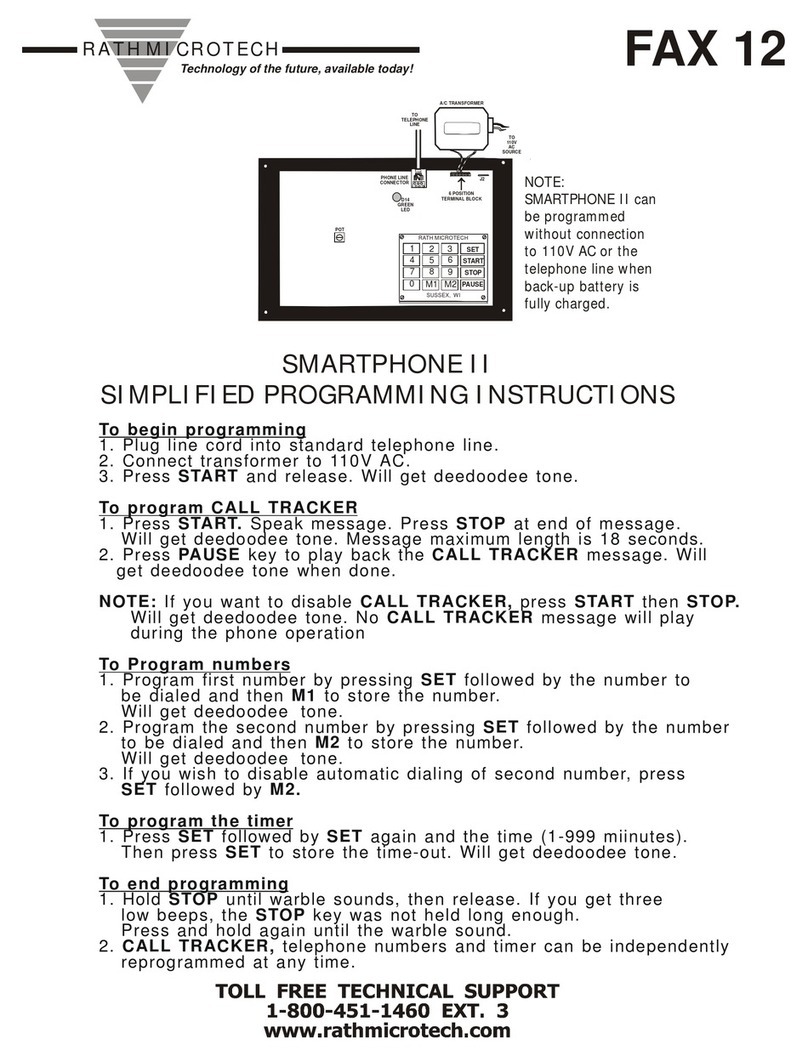
RATH MICROTECH
RATH MICROTECH SMARTPHONE II Simplified Programming Instructions

DMG
DMG amigo installation manual
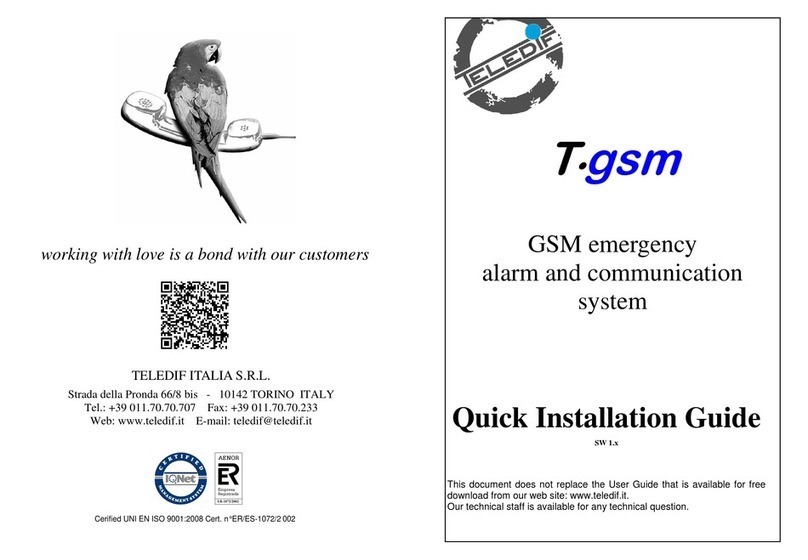
Teledif
Teledif T-gsm Quick installation guide
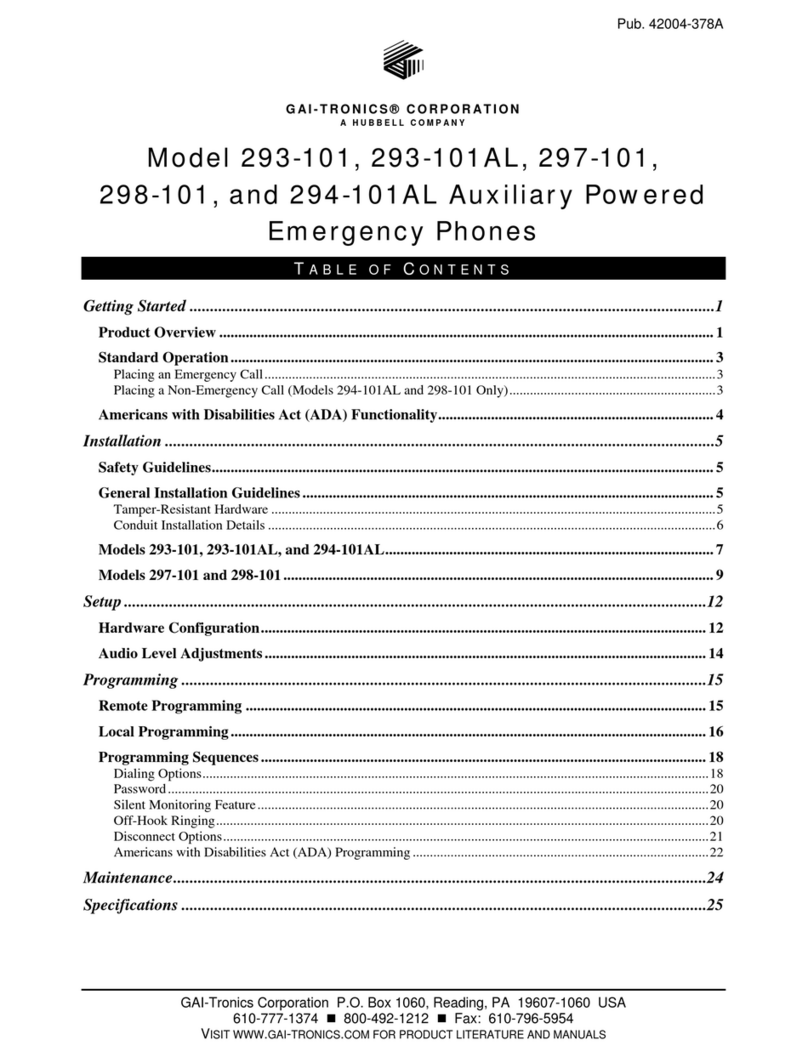
Hubbell
Hubbell GAI-TRONICS 293-101 manual
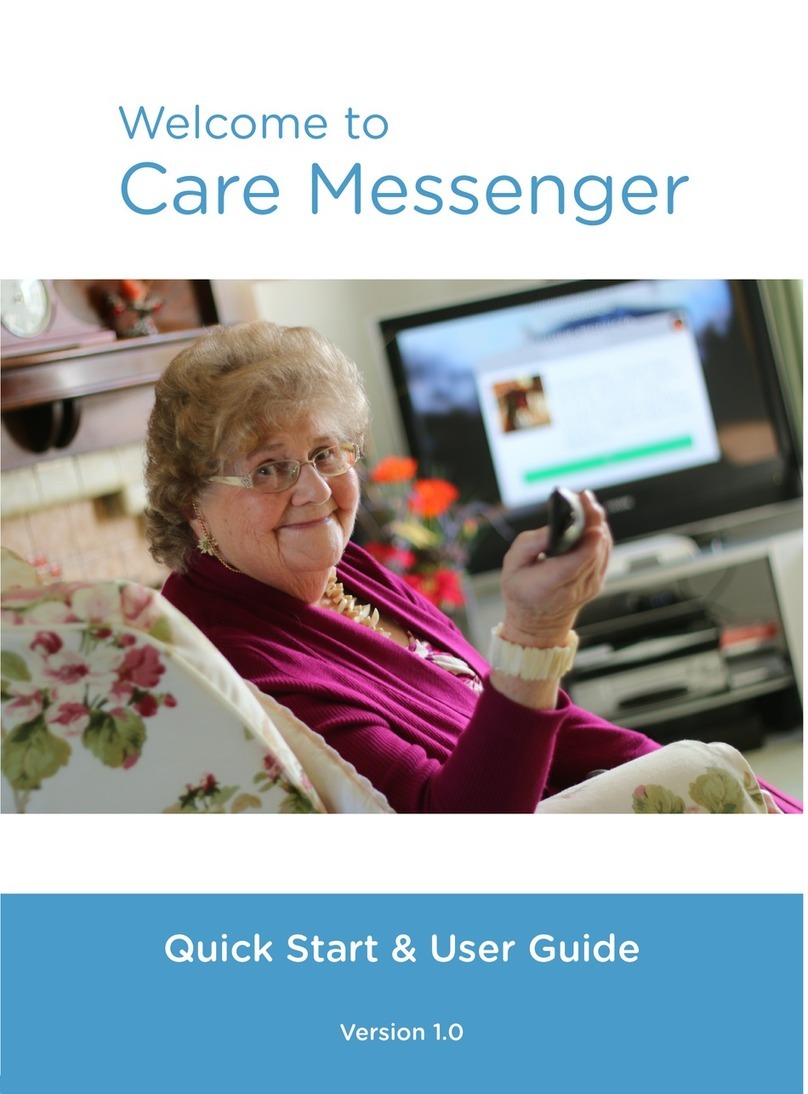
Care Messenger
Care Messenger Emergency Phone Quick start user guide
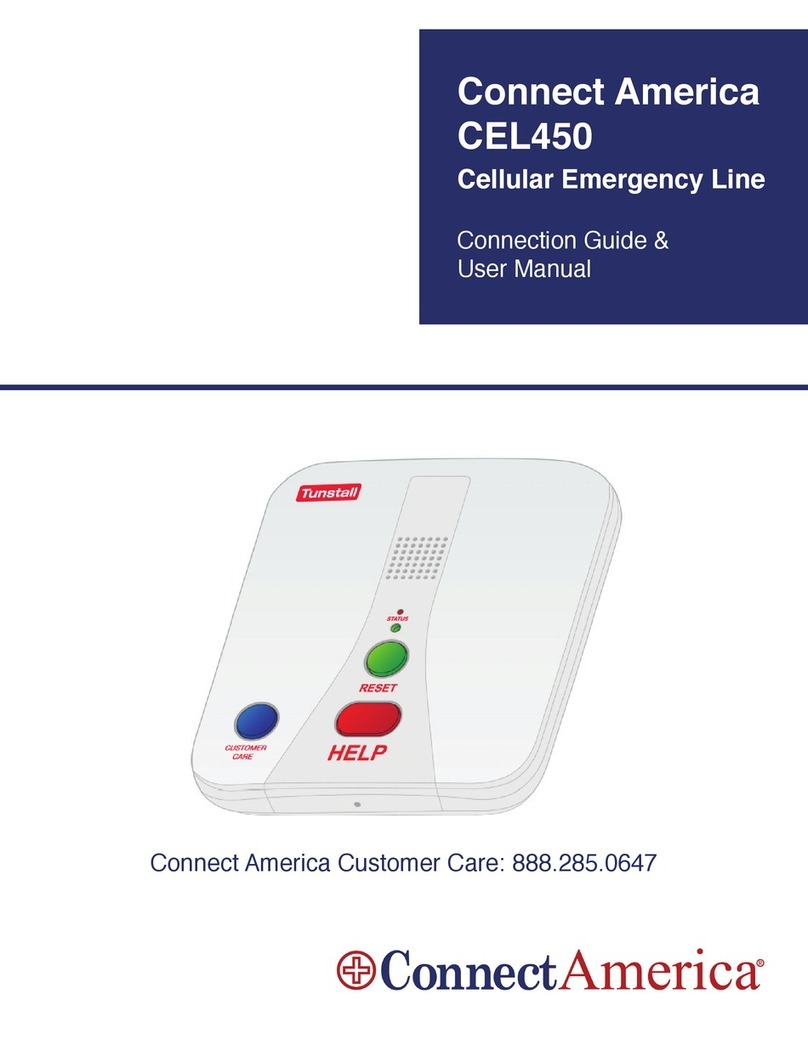
Tunstall
Tunstall Connect America CEL450 Connection Guide & User Manual

